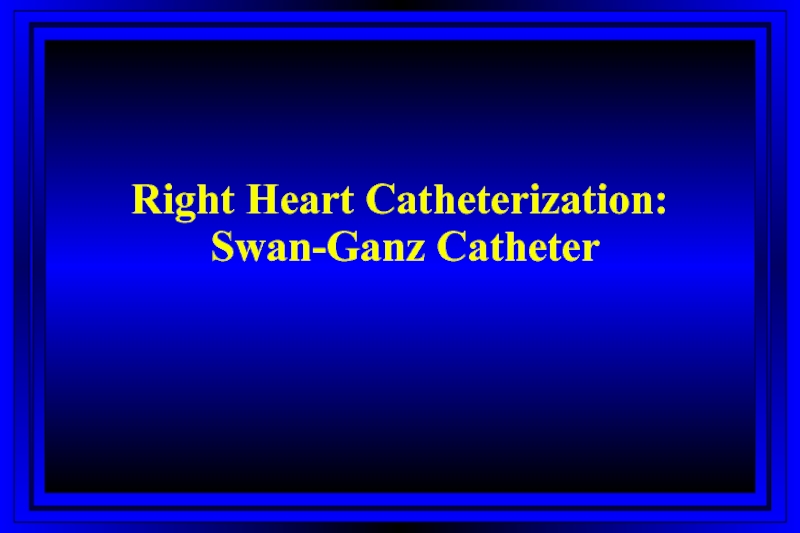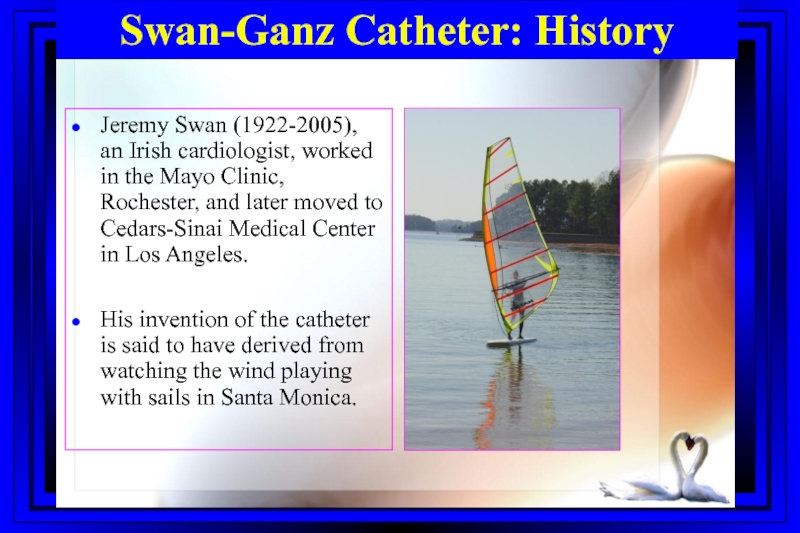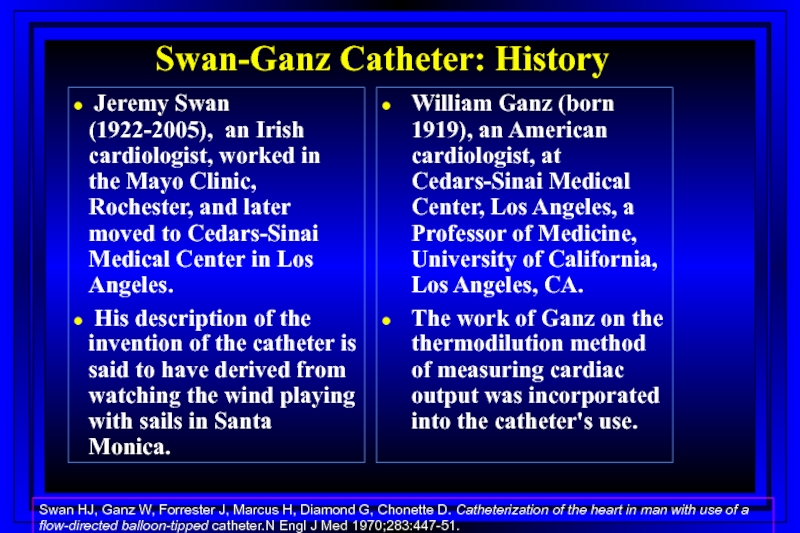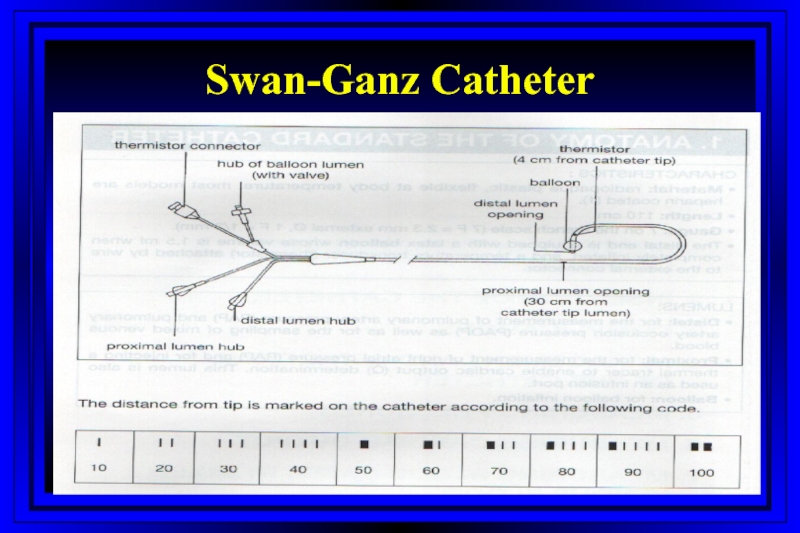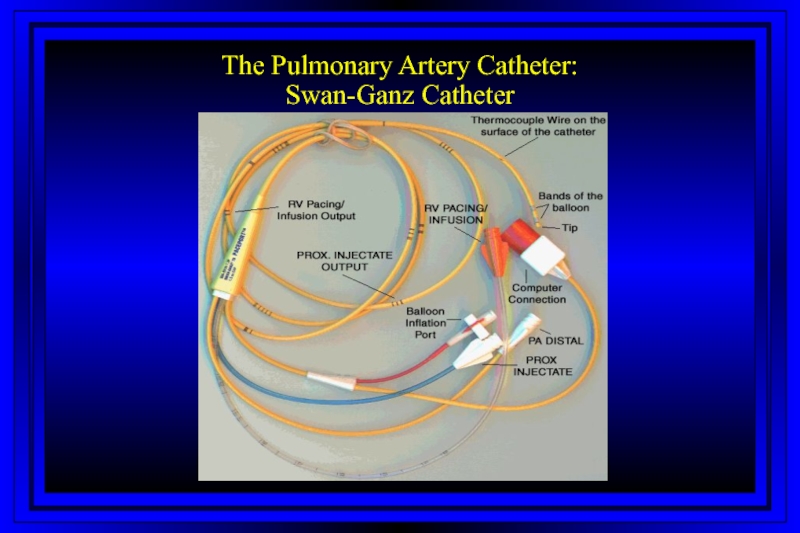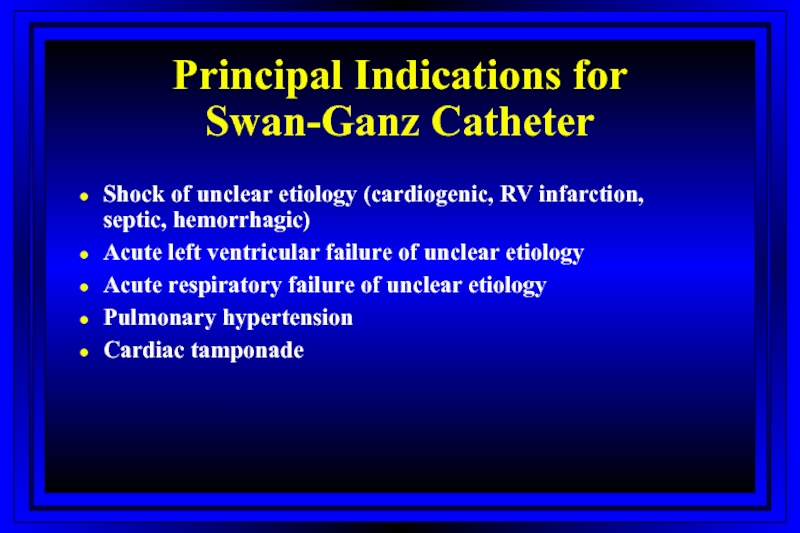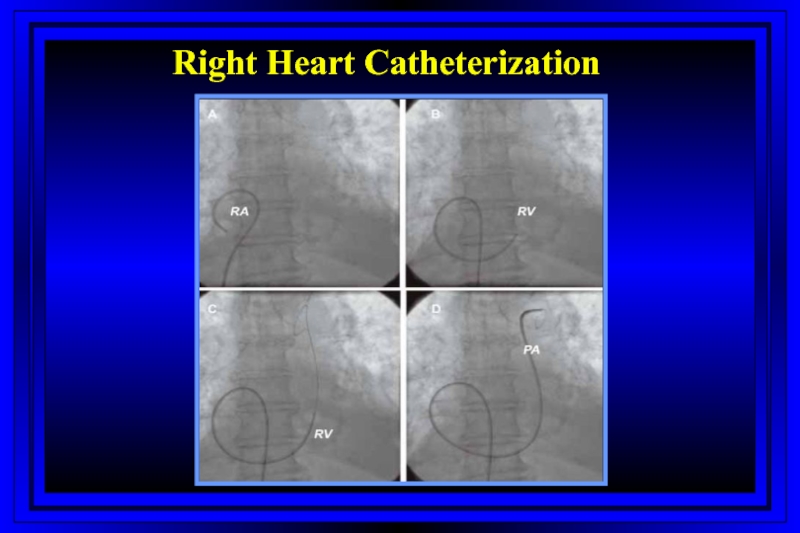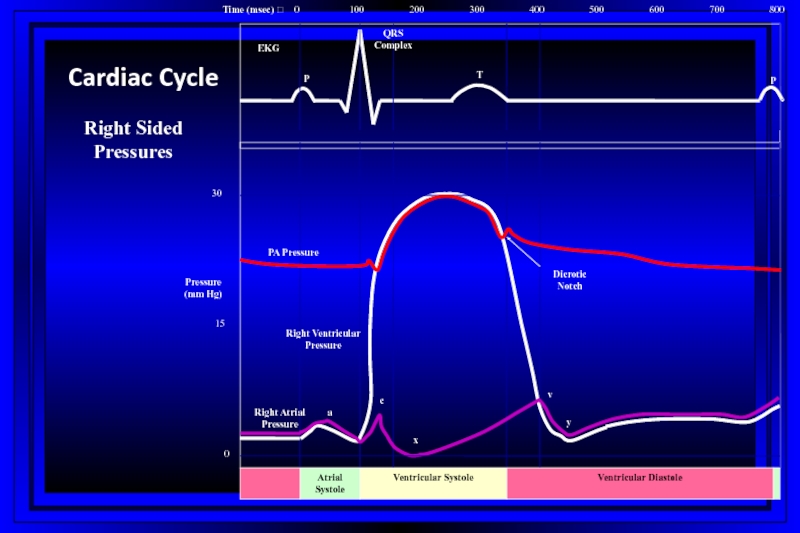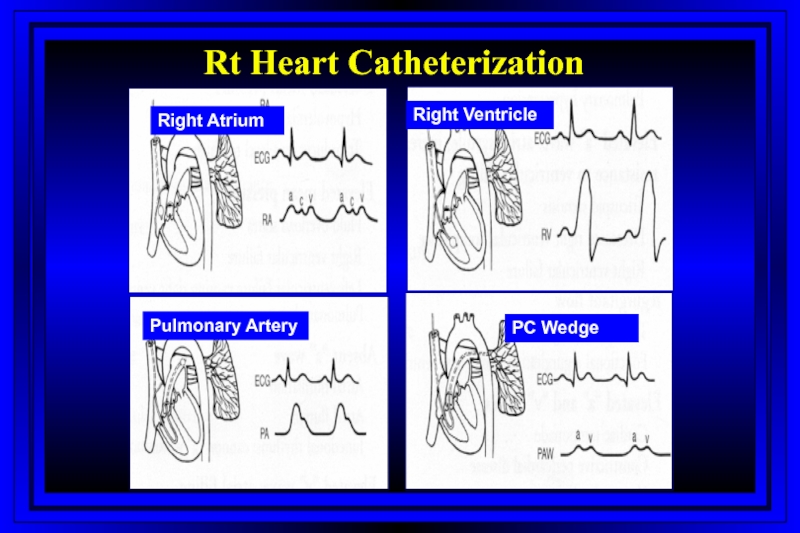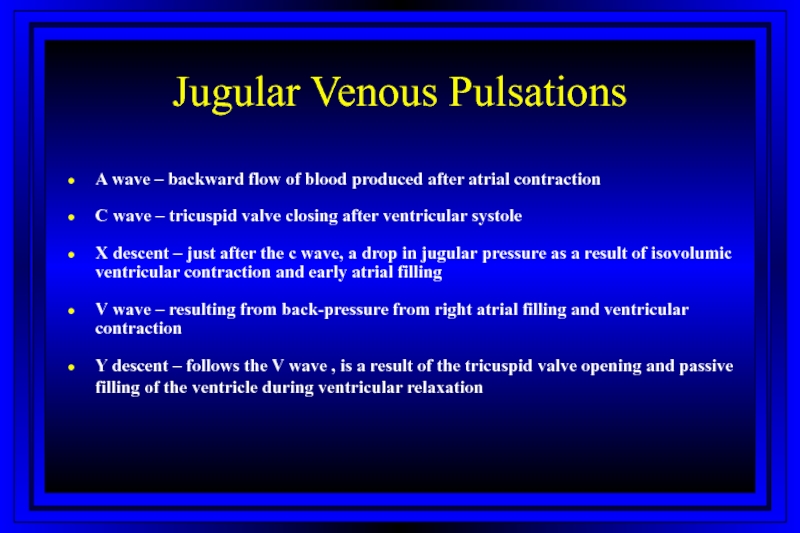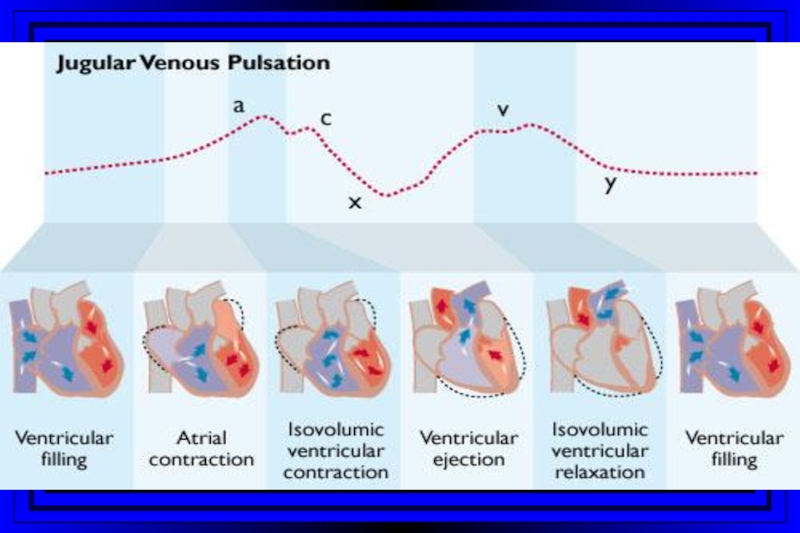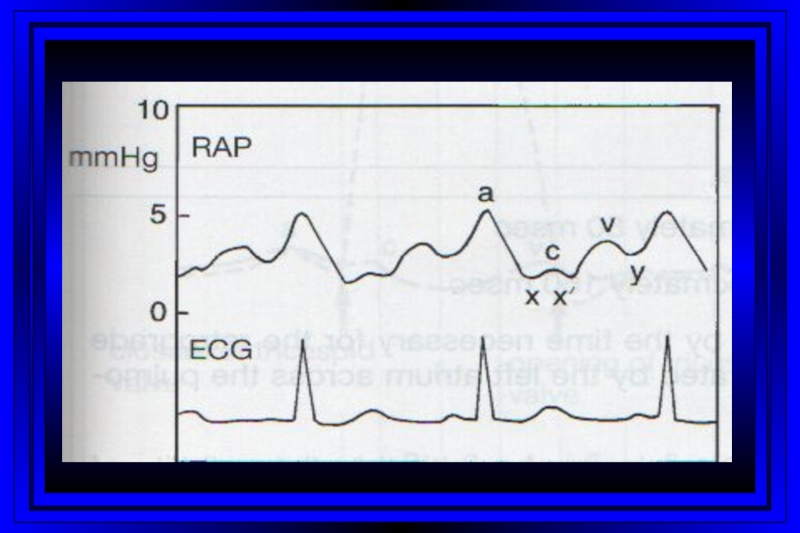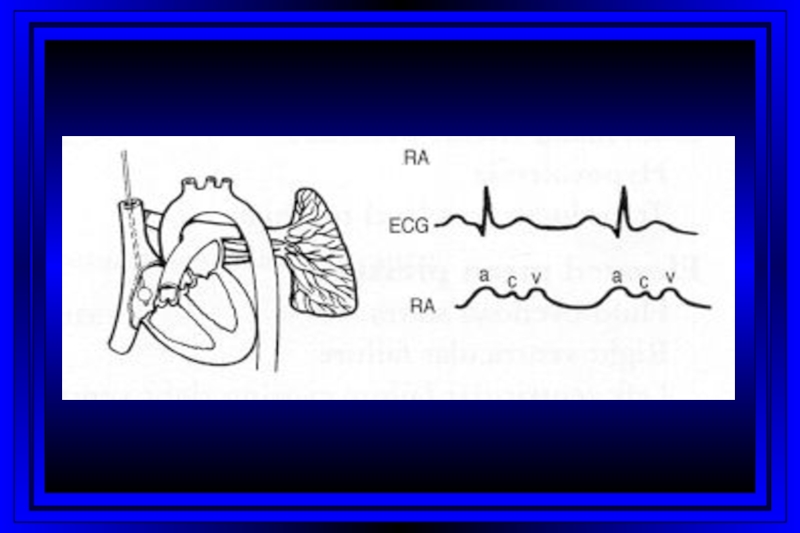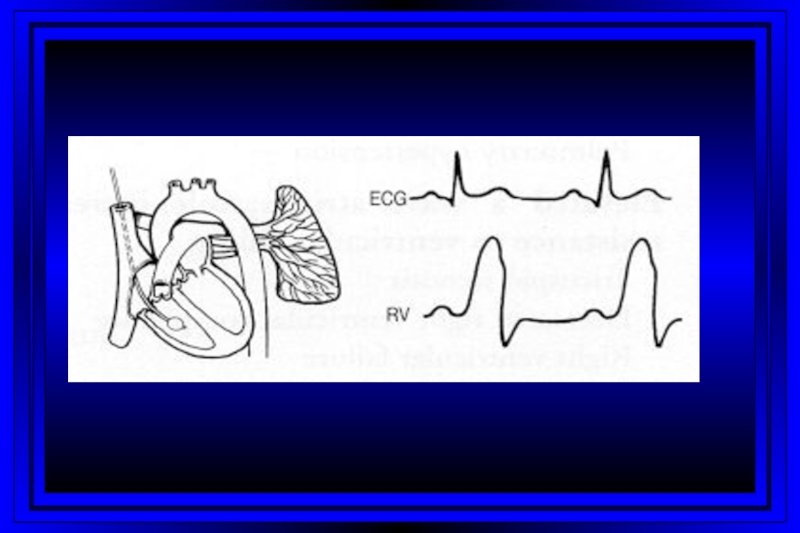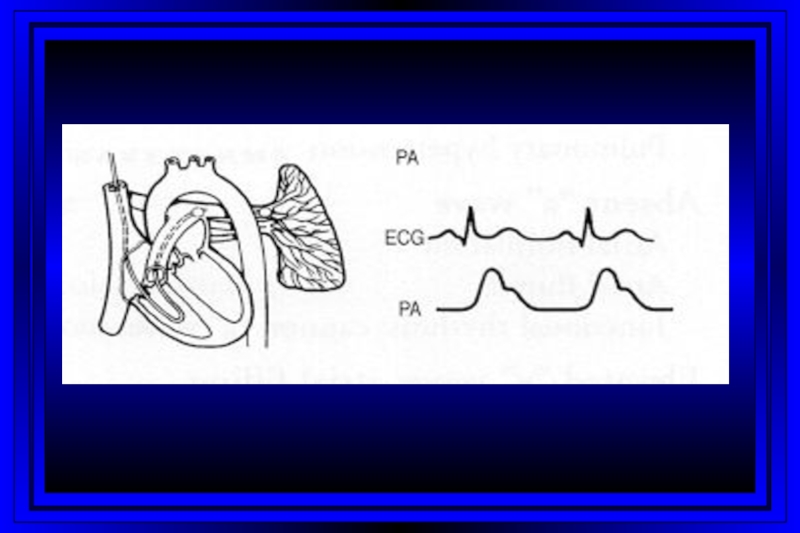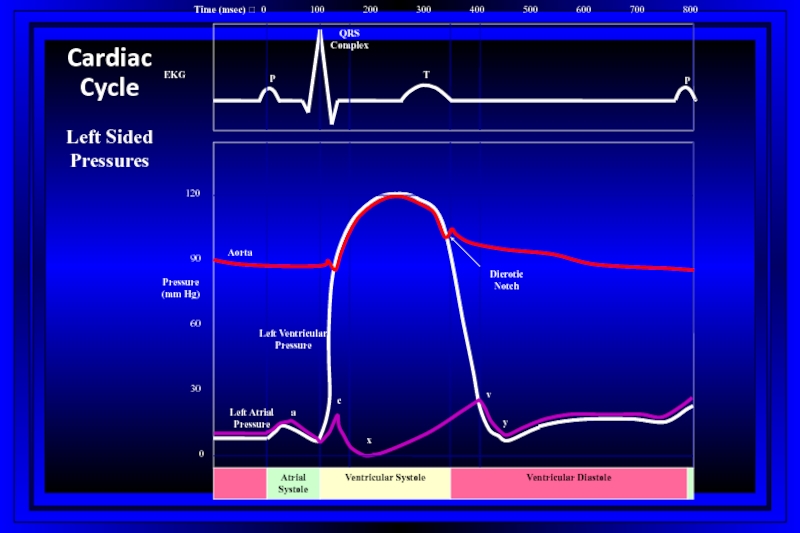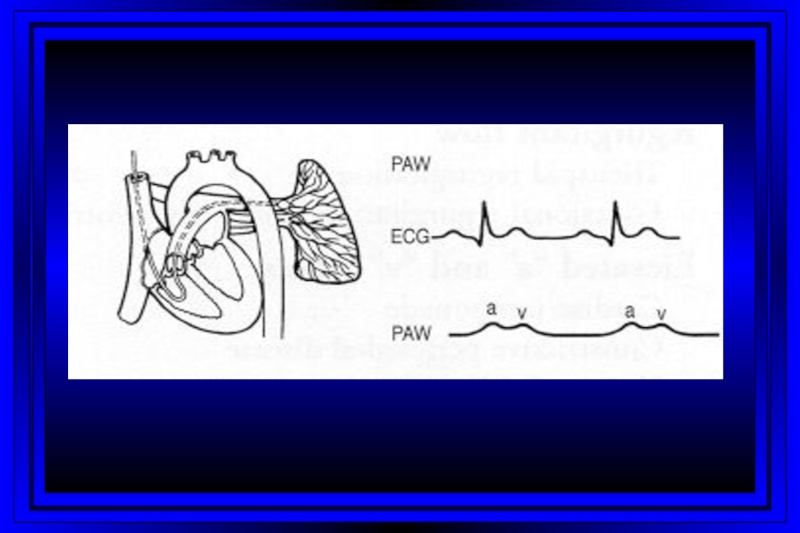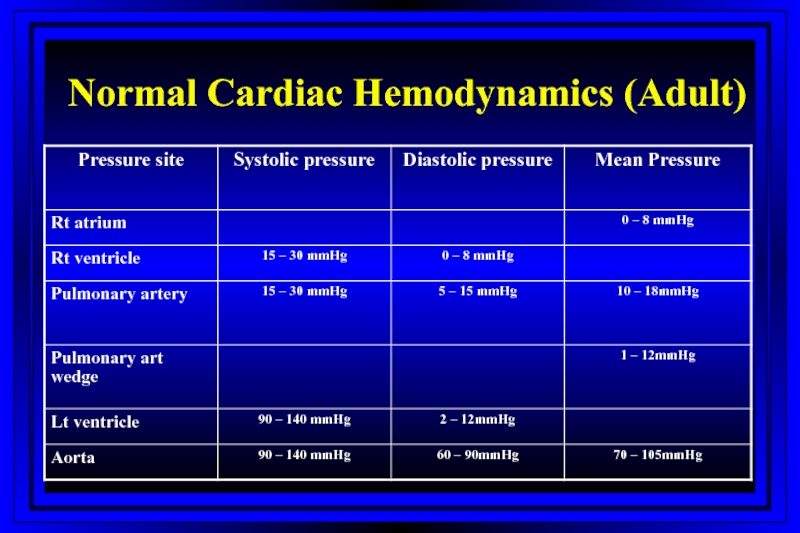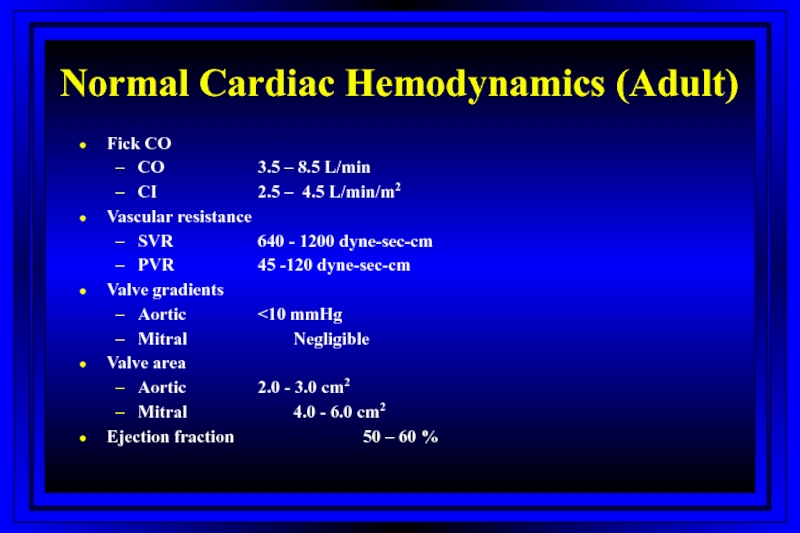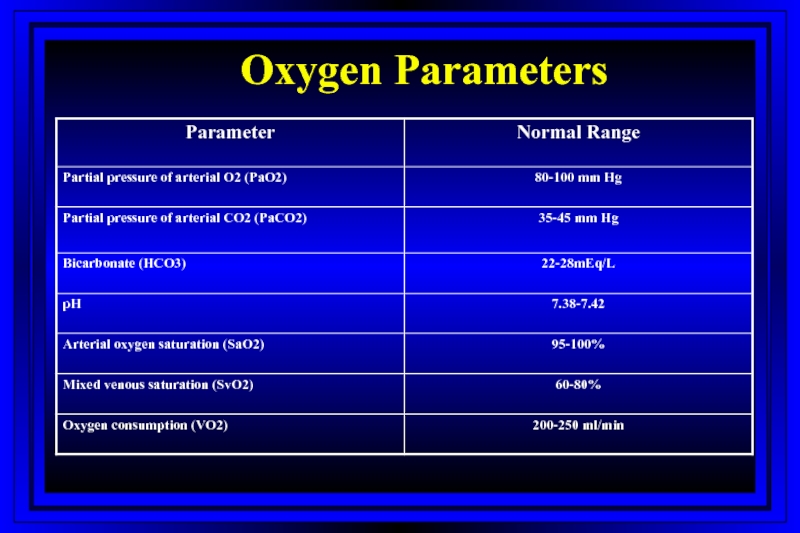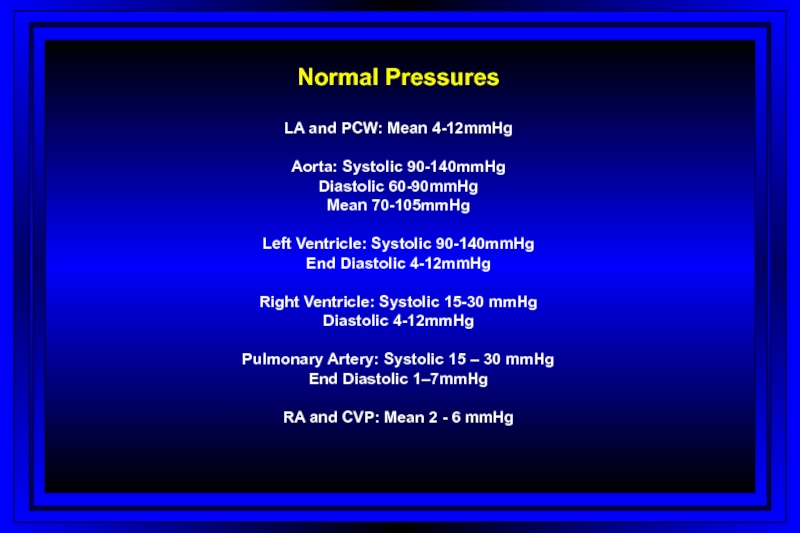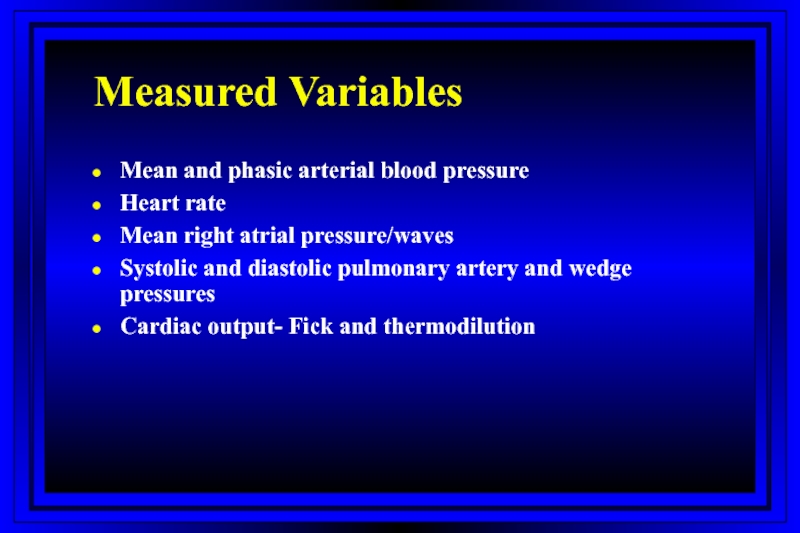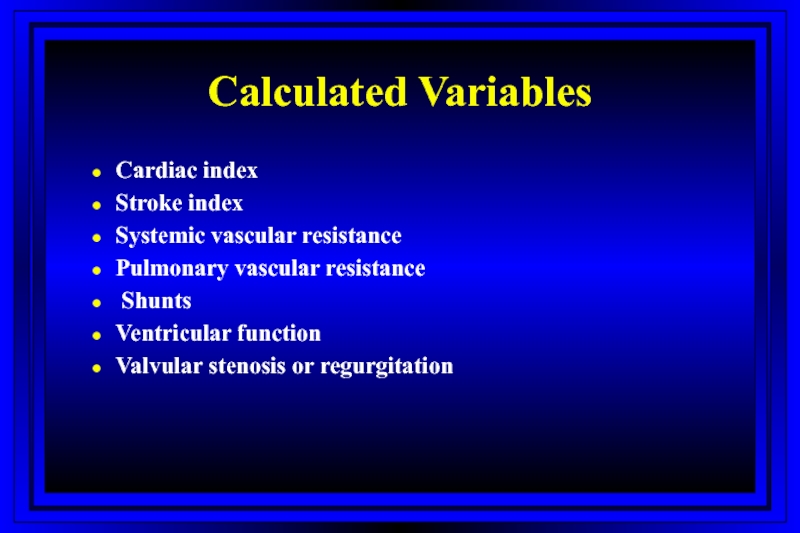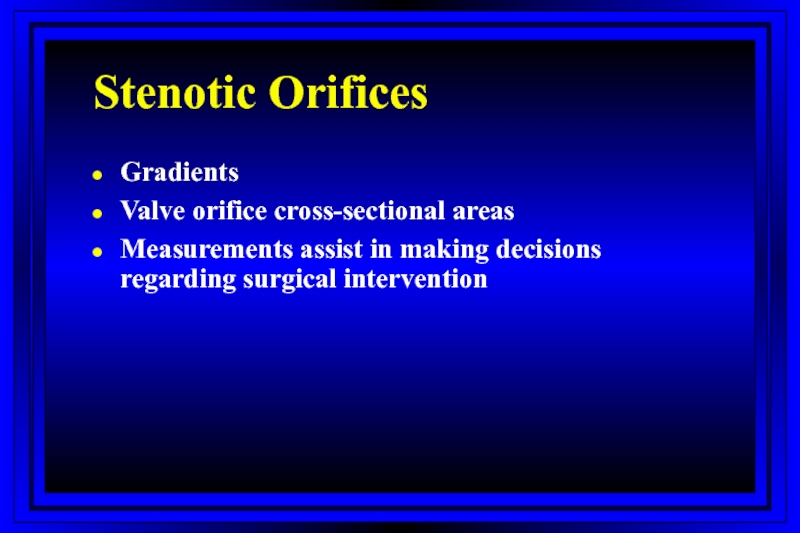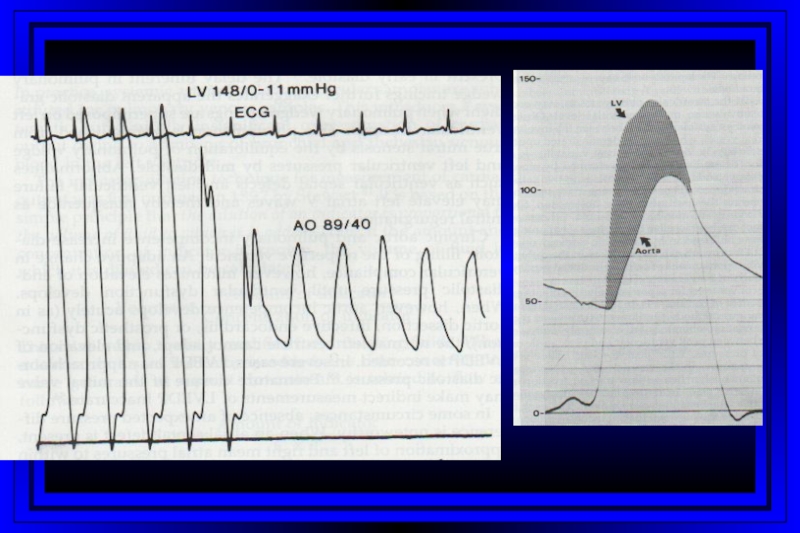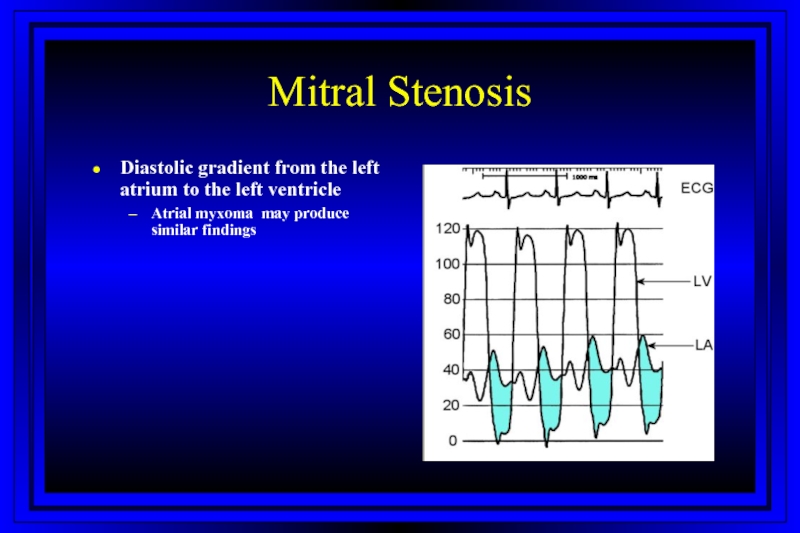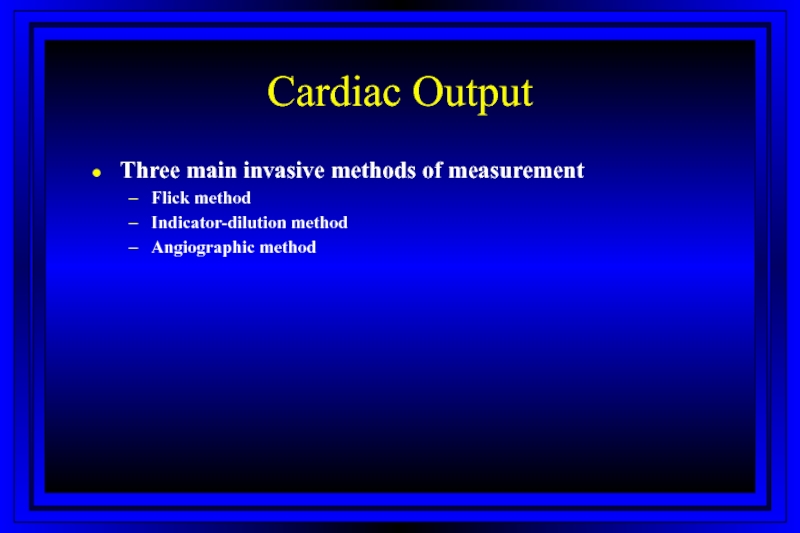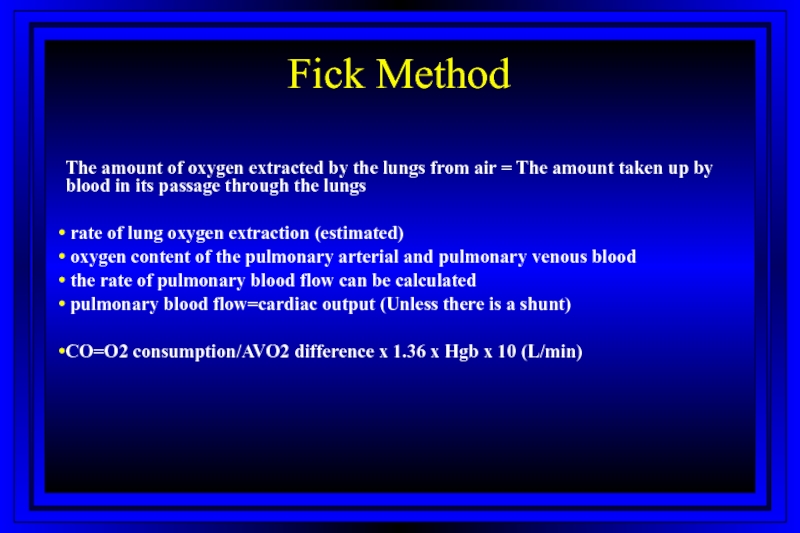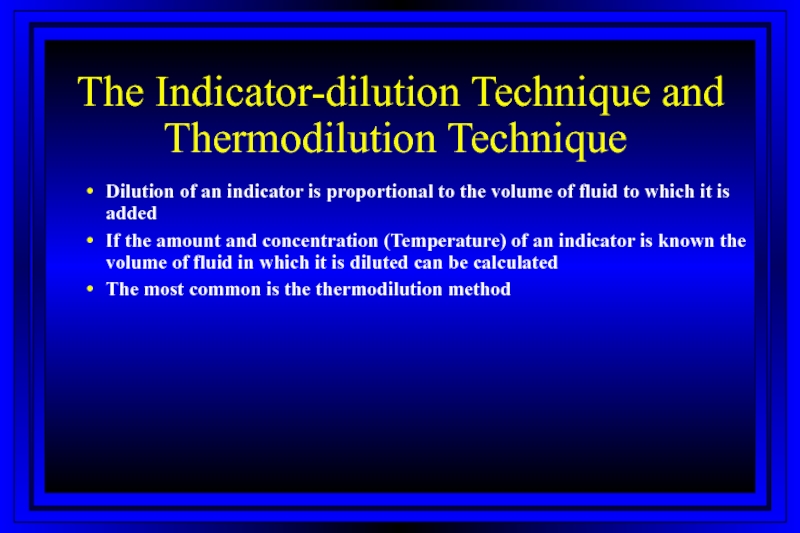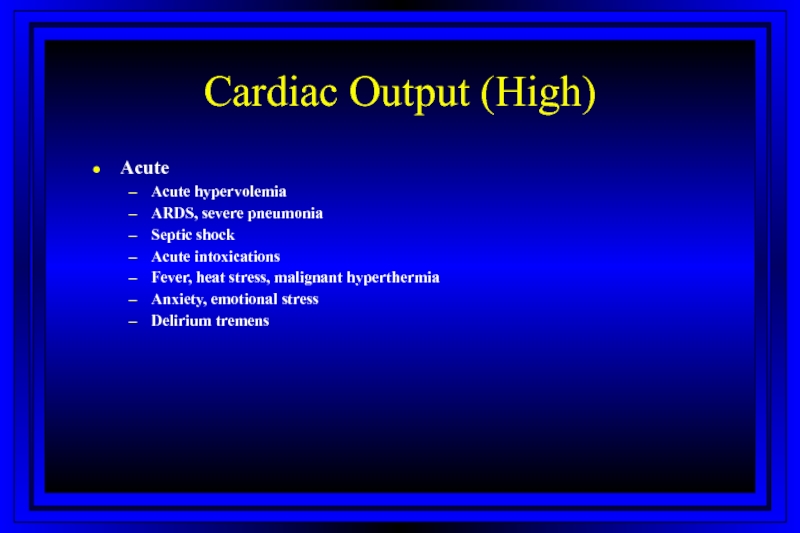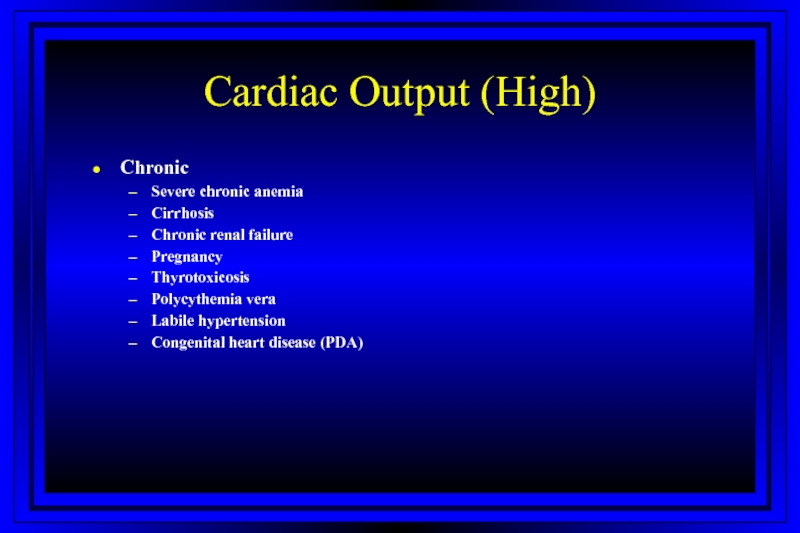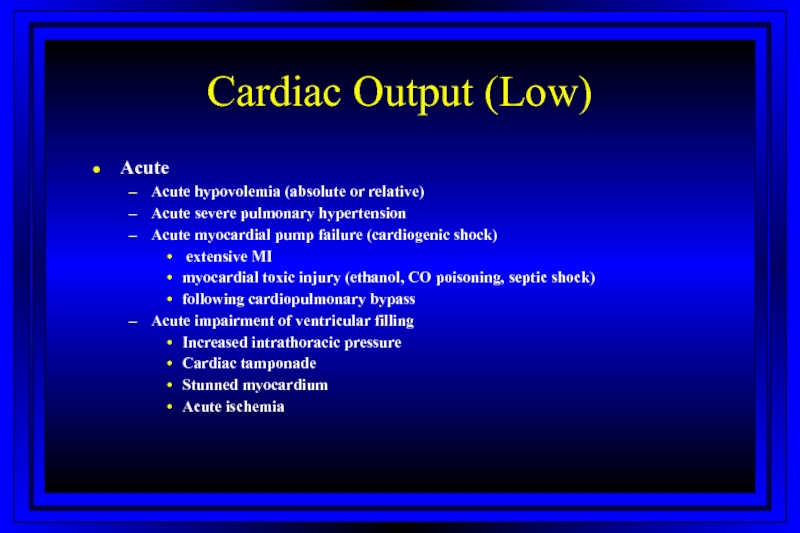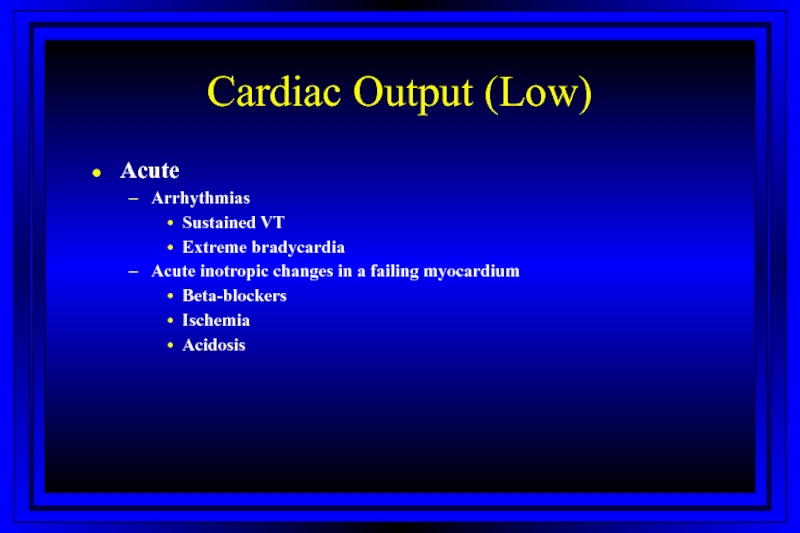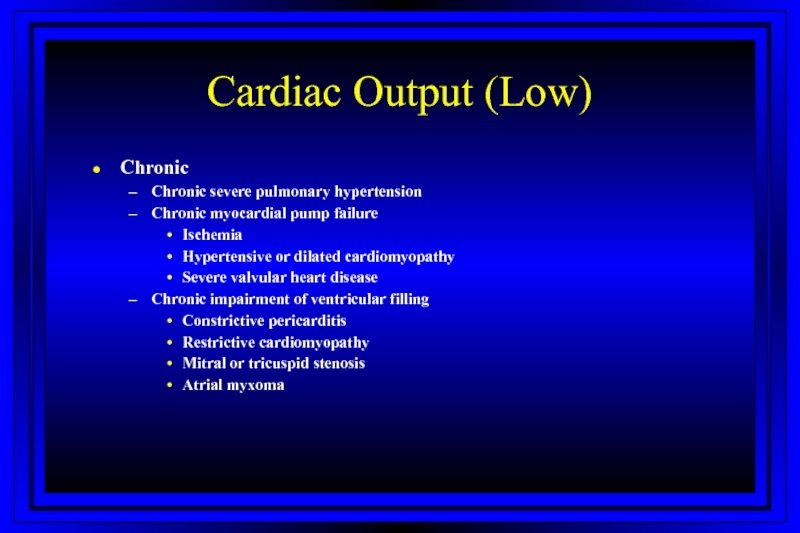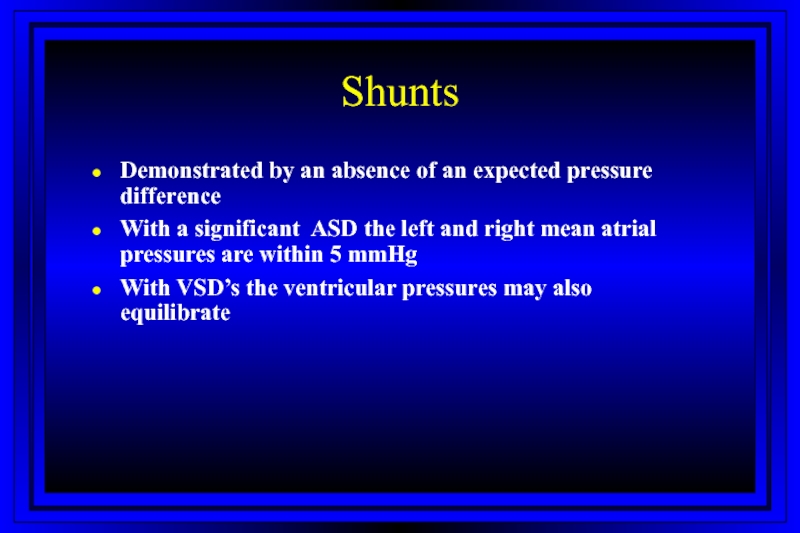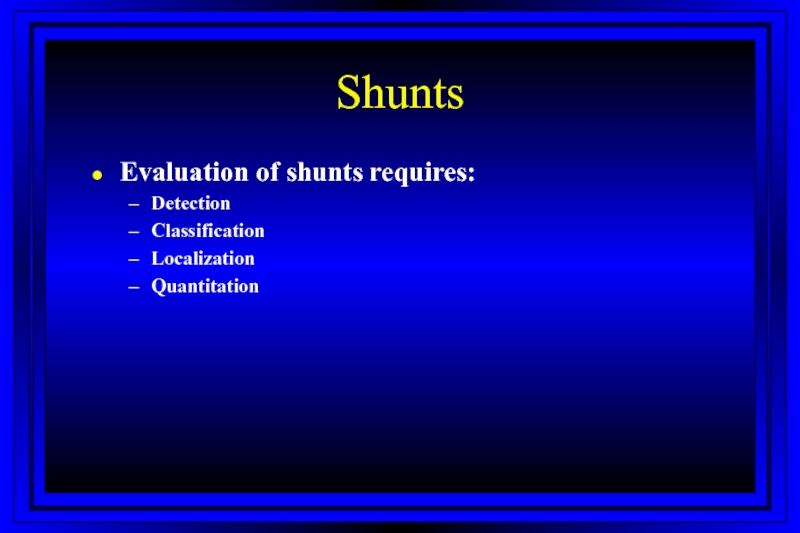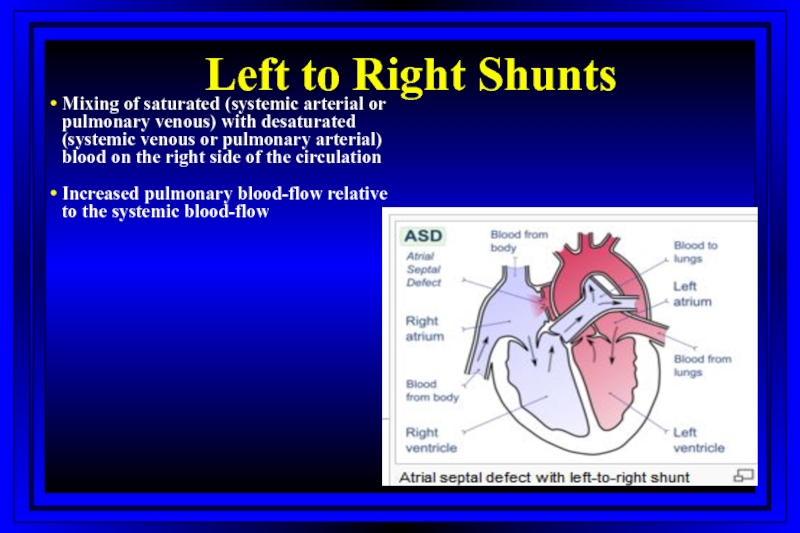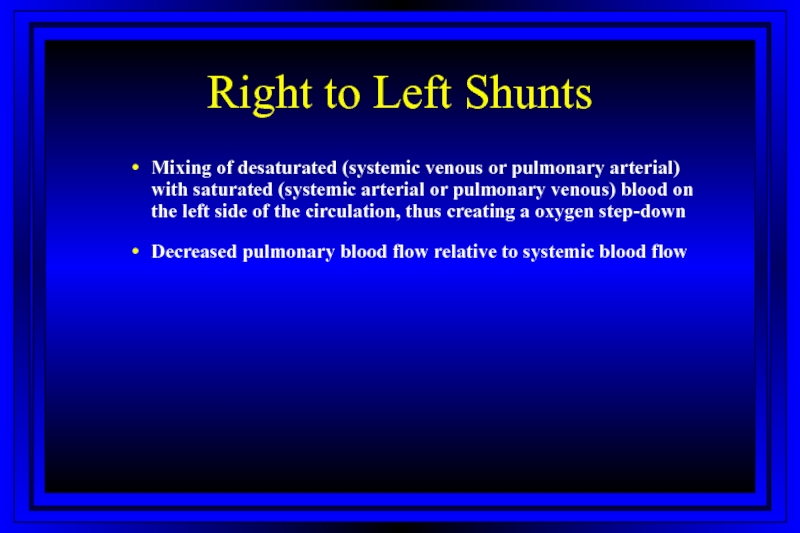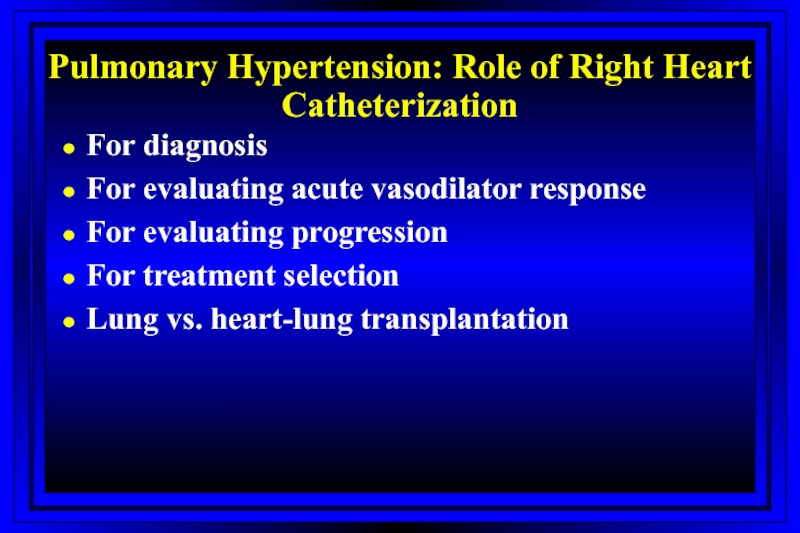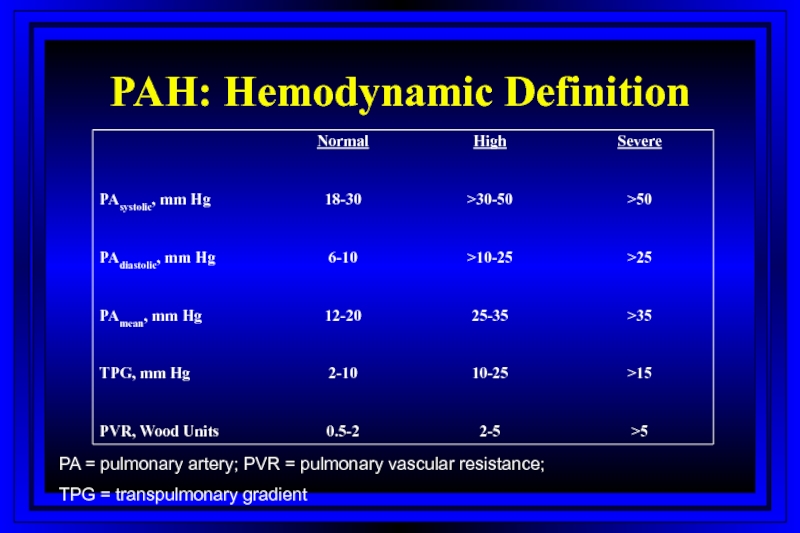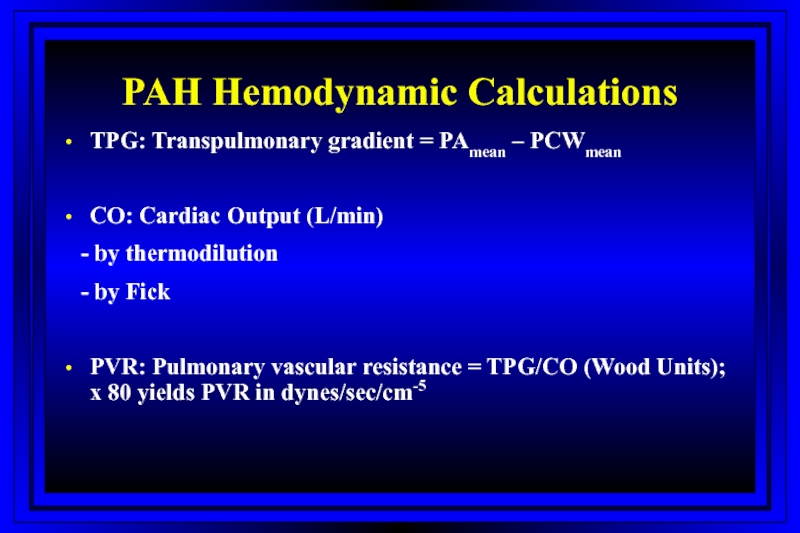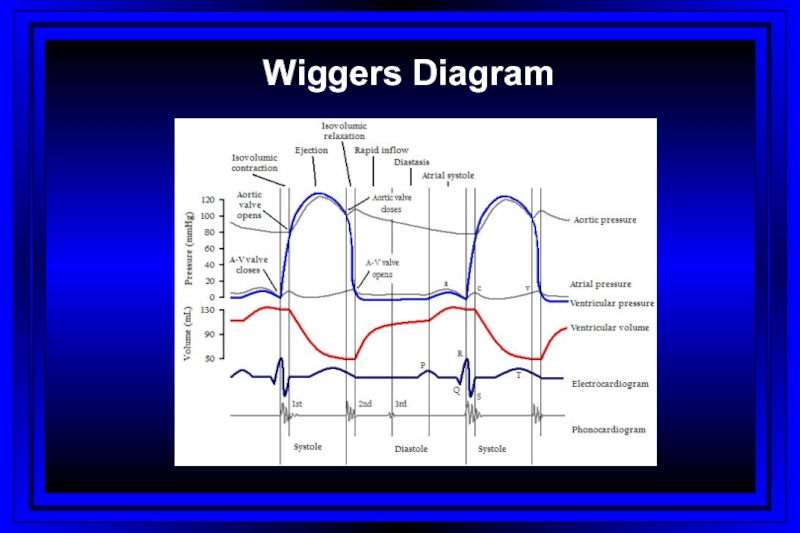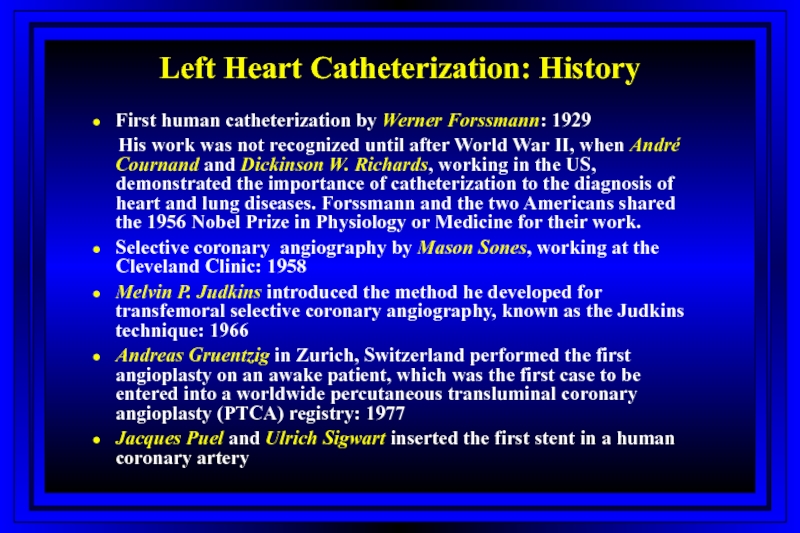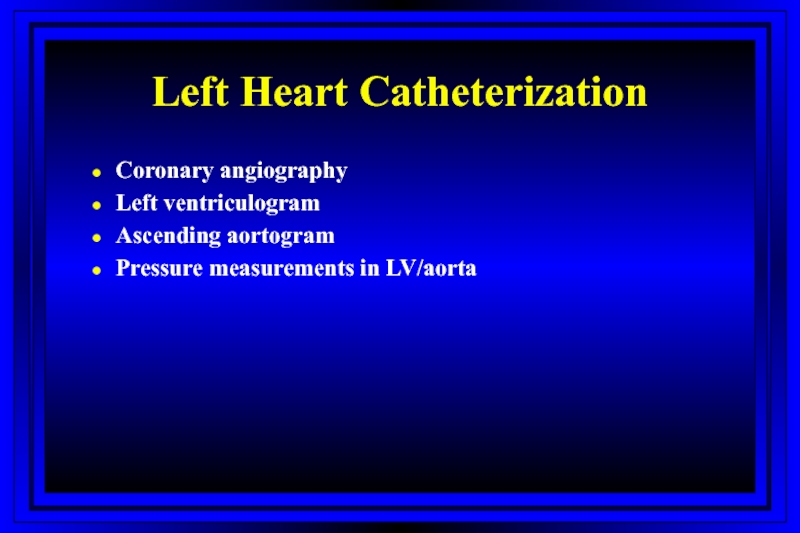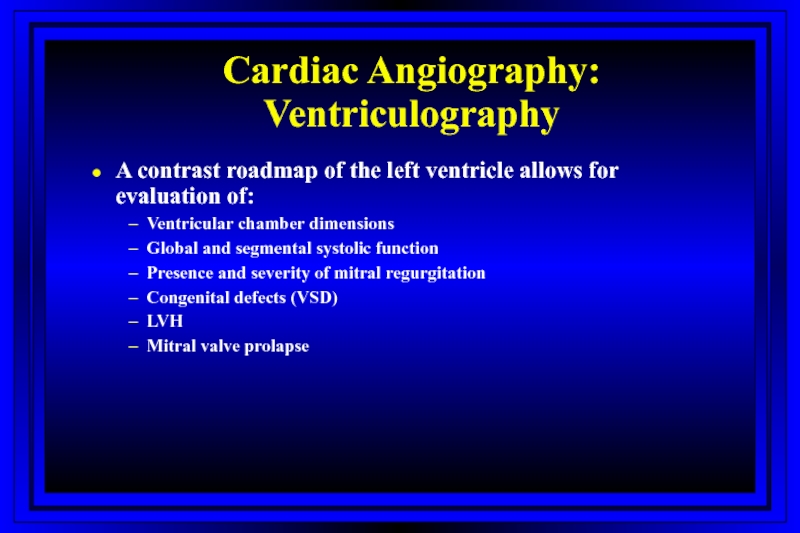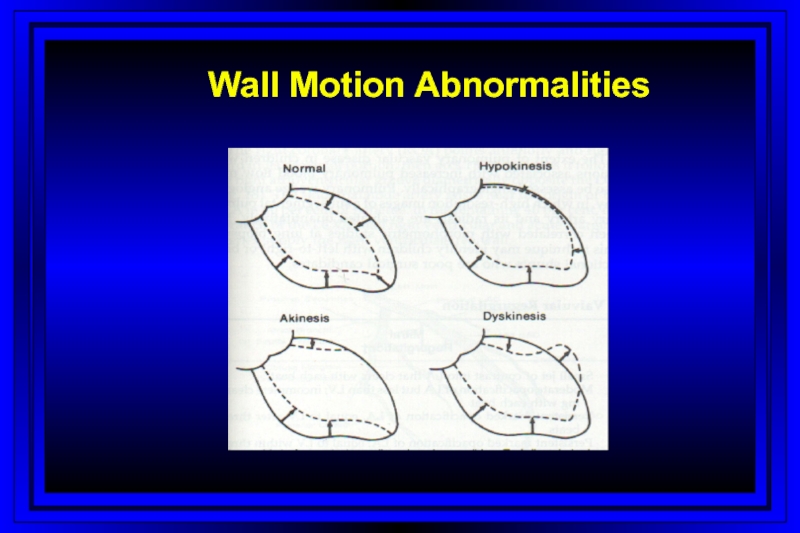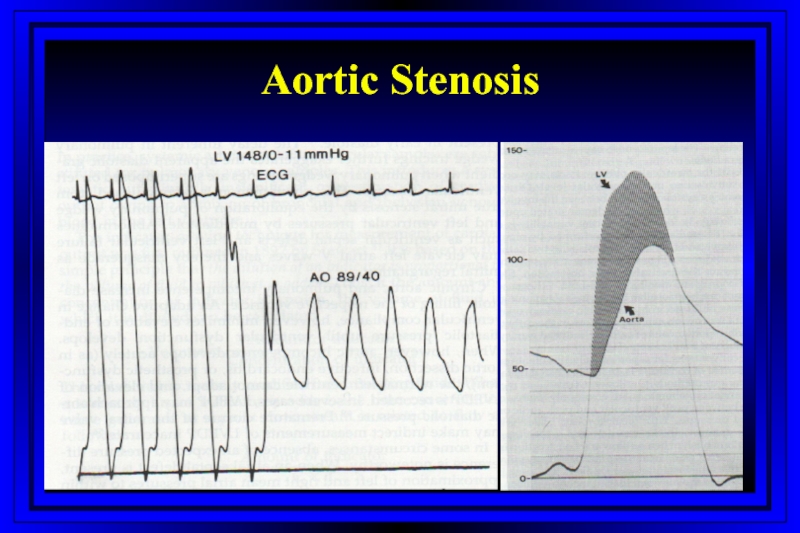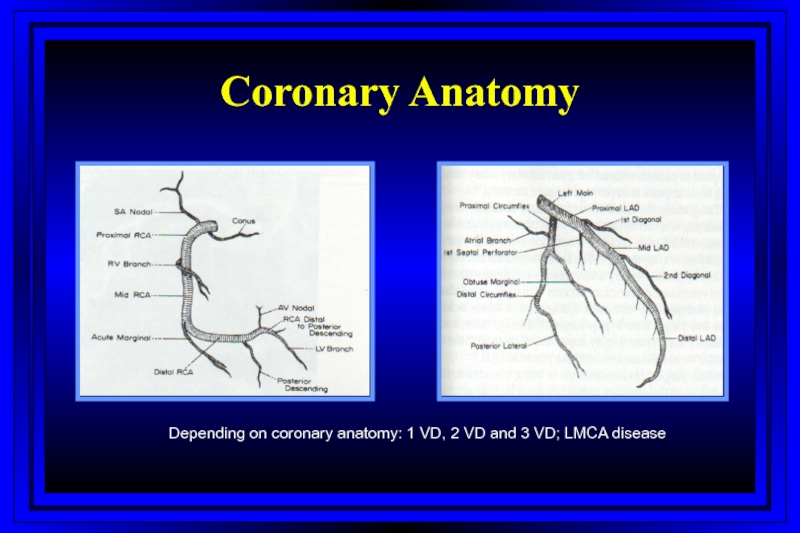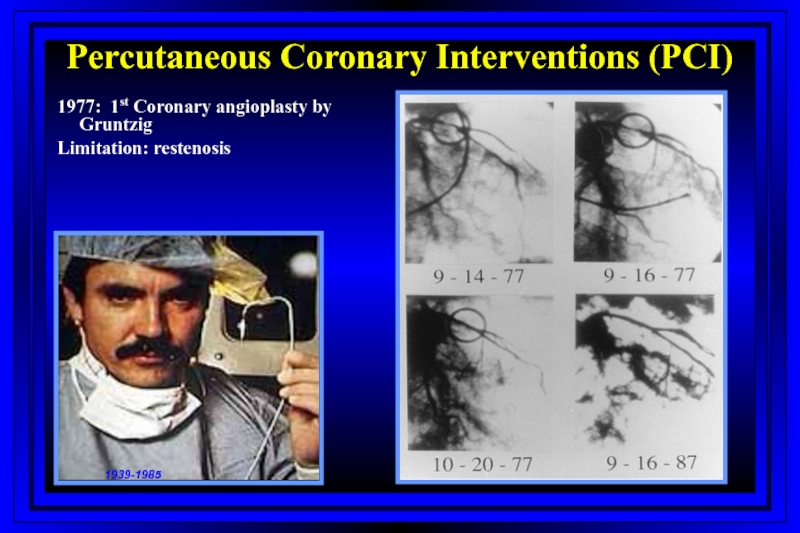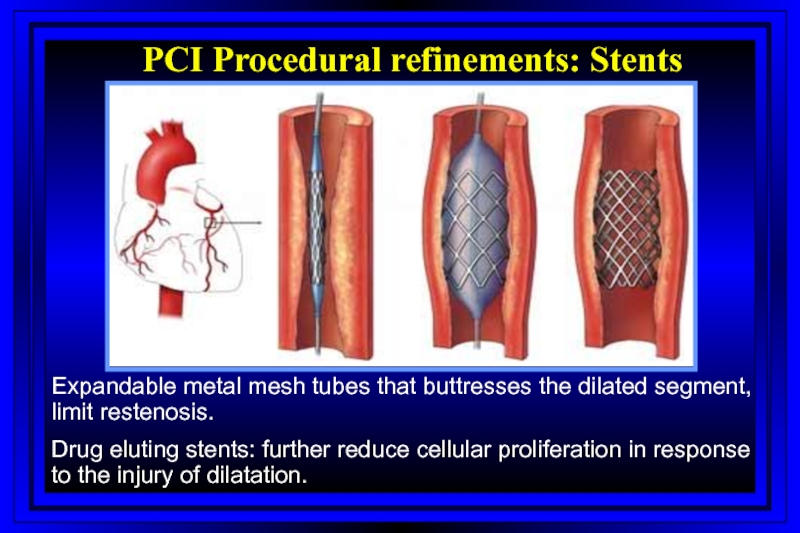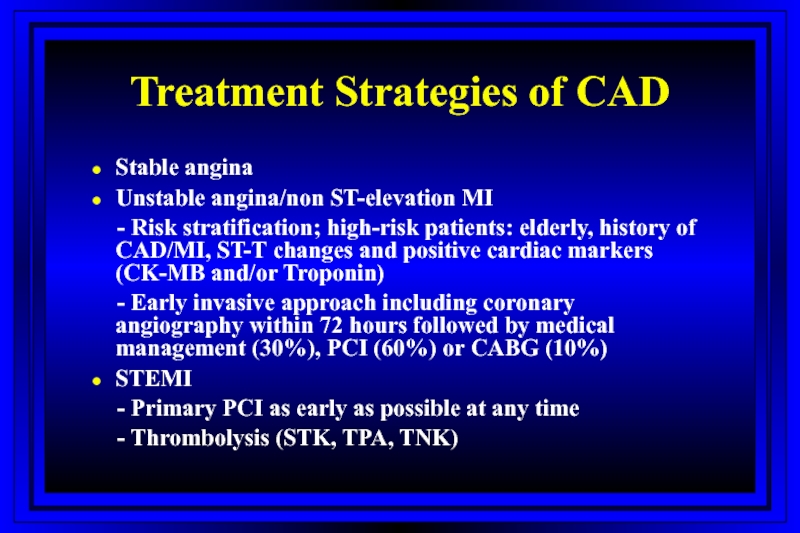- Главная
- Разное
- Дизайн
- Бизнес и предпринимательство
- Аналитика
- Образование
- Развлечения
- Красота и здоровье
- Финансы
- Государство
- Путешествия
- Спорт
- Недвижимость
- Армия
- Графика
- Культурология
- Еда и кулинария
- Лингвистика
- Английский язык
- Астрономия
- Алгебра
- Биология
- География
- Детские презентации
- Информатика
- История
- Литература
- Маркетинг
- Математика
- Медицина
- Менеджмент
- Музыка
- МХК
- Немецкий язык
- ОБЖ
- Обществознание
- Окружающий мир
- Педагогика
- Русский язык
- Технология
- Физика
- Философия
- Химия
- Шаблоны, картинки для презентаций
- Экология
- Экономика
- Юриспруденция
Right Heart Catheterization: Swan-Ganz Catheter презентация
Содержание
- 1. Right Heart Catheterization: Swan-Ganz Catheter
- 2. Right Heart Catheterization Swan-Ganz Catheter: History Jeremy
- 3. Swan-Ganz Catheter: History Jeremy Swan (1922-2005),
- 4. Swan-Ganz Catheter
- 5. The Pulmonary Artery Catheter: Swan-Ganz Catheter
- 6. Principal Indications for Swan-Ganz Catheter Shock
- 7. Right Heart Catheterization
- 8. 0 100 200 300 400 500 600
- 9. Right Atrium Right Ventricle Pulmonary Artery PC Wedge Rt Heart Catheterization
- 10. Jugular Venous Pulsations A wave – backward
- 16. 0 100 200 300 400 500 600
- 18. Normal Cardiac Hemodynamics (Adult)
- 19. Normal Cardiac Hemodynamics (Adult) Fick CO
- 20. Oxygen Parameters
- 21. Normal Pressures LA and PCW: Mean
- 22. Measured Variables Mean and phasic arterial blood
- 23. Calculated Variables Cardiac index Stroke index Systemic
- 24. Stenotic Orifices Gradients Valve orifice cross-sectional areas Measurements assist in making decisions regarding surgical intervention
- 26. Mitral Stenosis Diastolic gradient from the left
- 27. Cardiac Output Three main invasive methods of measurement Flick method Indicator-dilution method Angiographic method
- 28. Fick Method The amount of oxygen
- 29. The Indicator-dilution Technique and Thermodilution
- 30. Cardiac Output (High) Acute Acute hypervolemia ARDS,
- 31. Cardiac Output (High) Chronic Severe chronic anemia
- 32. Cardiac Output (Low) Acute Acute hypovolemia (absolute
- 33. Cardiac Output (Low) Acute Arrhythmias Sustained VT
- 34. Cardiac Output (Low) Chronic Chronic severe pulmonary
- 35. Shunts Demonstrated by an absence of an
- 36. Shunts Evaluation of shunts requires: Detection Classification Localization Quantitation
- 37. Left to Right Shunts Mixing of saturated
- 38. Right to Left Shunts Mixing of desaturated
- 39. Pulmonary Hypertension: Role of Right Heart Catheterization
- 40. PAH: Hemodynamic Definition PA = pulmonary artery;
- 41. PAH Hemodynamic Calculations TPG: Transpulmonary gradient =
- 42. Swan-Ganz Catheter Related Complications Harvey S et al. The Lancet 2005; 366:472-477
- 43. Wiggers Diagram
- 44. Left Heart Catheterization: History First human
- 45. Vascular Access: Left Heart Cath Sones’ technique (brachial approach) Judkin’s technique (femoral approach) Radial approach
- 46. Left Heart Catheterization Coronary angiography Left ventriculogram Ascending aortogram Pressure measurements in LV/aorta
- 47. Cardiac Angiography: Ventriculography A contrast roadmap of
- 48. Wall Motion Abnormalities
- 49. Aortic Stenosis
- 50. Coronary Anatomy Depending on coronary anatomy: 1
- 51. Treatment Strategies of CAD Medical treatment, PCI
- 52. Percutaneous Coronary Interventions (PCI) 1977: 1st Coronary angioplasty by Gruntzig Limitation: restenosis 1939-1985
- 53. PCI Procedural refinements: Stents Expandable metal mesh
- 54. Treatment Strategies of CAD Stable angina Unstable
- 55. Treatment Strategies of CAD Stable angina Unstable
- 56. STEMI: PCI vs. Thrombolysis Advantages of PCI
- 57. Baseline LAO Baseline LAO/Cranial Baseline RAO Baseline
- 58. Post PTCA with stent
- 59. Left Heart Catheterization: Complications Early: Death: 0.1-0.2%
- 60. Contrast Induced Nephropathy: Pathogenesis Hemodynamic changes
- 61. Risk Factors for the Development of Contrast-Induced Nephropathy
- 62. Treatment Modalities Assessed in Randomized Trials on
- 63. Intraaortic Balloon Catheter Inner Pressure Lumen Gas Shuttle Lumen Catheter Tip Membrane Sheath
- 64. • ¯ Cardiac Work • ¯ Myocardial
- 65. Impella Device
- 66. SYNERGY 1994 1995 1996 1997 1998 1999
- 67. Dynamics of Antithrombotic Therapy in Patients with
- 68. Mechanical Heart Failure Devices Mancini D, Burkoff D, Circulation, 2005;112:438-446
- 69. PARTNER Study Design N = 358 Inoperable
- 70. All-Cause Mortality Landmark Analysis
- 71. Catheter-Based Mitral Valve Repair: MitraClip® System
- 72. Investigational Device only in the US; Not
- 73. Safety & effectiveness endpoints met Safety: MAE
Слайд 2Right Heart Catheterization
Swan-Ganz Catheter: History
Jeremy Swan (1922-2005), an Irish cardiologist, worked
His invention of the catheter is said to have derived from watching the wind playing with sails in Santa Monica.
Слайд 3Swan-Ganz Catheter: History
Jeremy Swan (1922-2005), an Irish cardiologist, worked in
His description of the invention of the catheter is said to have derived from watching the wind playing with sails in Santa Monica.
William Ganz (born 1919), an American cardiologist, at Cedars-Sinai Medical Center, Los Angeles, a Professor of Medicine, University of California, Los Angeles, CA.
The work of Ganz on the thermodilution method of measuring cardiac output was incorporated into the catheter's use.
Swan HJ, Ganz W, Forrester J, Marcus H, Diamond G, Chonette D. Catheterization of the heart in man with use of a flow-directed balloon-tipped catheter.N Engl J Med 1970;283:447-51.
Слайд 6Principal Indications for
Swan-Ganz Catheter
Shock of unclear etiology (cardiogenic, RV infarction,
Acute left ventricular failure of unclear etiology
Acute respiratory failure of unclear etiology
Pulmonary hypertension
Cardiac tamponade
Слайд 80
100
200
300
400
500
600
700
800
0
15
30
Atrial Systole
Ventricular Systole
Ventricular Diastole
EKG
Time (msec)
Pressure (mm Hg)
P
QRS Complex
T
P
PA Pressure
Dicrotic Notch
Right
a
c
v
x
y
Right Atrial Pressure
Right Sided Pressures
Cardiac Cycle
Слайд 10Jugular Venous Pulsations
A wave – backward flow of blood produced after
C wave – tricuspid valve closing after ventricular systole
X descent – just after the c wave, a drop in jugular pressure as a result of isovolumic ventricular contraction and early atrial filling
V wave – resulting from back-pressure from right atrial filling and ventricular contraction
Y descent – follows the V wave , is a result of the tricuspid valve opening and passive filling of the ventricle during ventricular relaxation
Слайд 160
100
200
300
400
500
600
700
800
0
30
60
90
120
Atrial Systole
Ventricular Systole
Ventricular Diastole
EKG
Time (msec)
Pressure (mm Hg)
P
QRS Complex
T
P
Aorta
Dicrotic Notch
Left Ventricular
a
c
v
x
y
Left Atrial Pressure
Cardiac
Cycle
Left Sided Pressures
Слайд 19Normal Cardiac Hemodynamics (Adult)
Fick CO
CO 3.5 – 8.5 L/min
CI 2.5 – 4.5 L/min/m2
Vascular
SVR 640 - 1200 dyne-sec-cm
PVR 45 -120 dyne-sec-cm
Valve gradients
Aortic <10 mmHg
Mitral Negligible
Valve area
Aortic 2.0 - 3.0 cm2
Mitral 4.0 - 6.0 cm2
Ejection fraction 50 – 60 %
Слайд 21Normal Pressures
LA and PCW: Mean 4-12mmHg
Aorta: Systolic 90-140mmHg
Diastolic 60-90mmHg
Mean 70-105mmHg
Left Ventricle:
End Diastolic 4-12mmHg
Right Ventricle: Systolic 15-30 mmHg
Diastolic 4-12mmHg
Pulmonary Artery: Systolic 15 – 30 mmHg
End Diastolic 1–7mmHg
RA and CVP: Mean 2 - 6 mmHg
Слайд 22Measured Variables
Mean and phasic arterial blood pressure
Heart rate
Mean right atrial pressure/waves
Systolic
Cardiac output- Fick and thermodilution
Слайд 23Calculated Variables
Cardiac index
Stroke index
Systemic vascular resistance
Pulmonary vascular resistance
Shunts
Ventricular function
Valvular stenosis
Слайд 24Stenotic Orifices
Gradients
Valve orifice cross-sectional areas
Measurements assist in making decisions regarding surgical
Слайд 26Mitral Stenosis
Diastolic gradient from the left atrium to the left ventricle
Atrial
Слайд 27Cardiac Output
Three main invasive methods of measurement
Flick method
Indicator-dilution method
Angiographic method
Слайд 28Fick Method
The amount of oxygen extracted by the lungs from
rate of lung oxygen extraction (estimated)
oxygen content of the pulmonary arterial and pulmonary venous blood
the rate of pulmonary blood flow can be calculated
pulmonary blood flow=cardiac output (Unless there is a shunt)
CO=O2 consumption/AVO2 difference x 1.36 x Hgb x 10 (L/min)
Слайд 29
The Indicator-dilution Technique and Thermodilution Technique
Dilution of an indicator is
If the amount and concentration (Temperature) of an indicator is known the volume of fluid in which it is diluted can be calculated
The most common is the thermodilution method
Слайд 30Cardiac Output (High)
Acute
Acute hypervolemia
ARDS, severe pneumonia
Septic shock
Acute intoxications
Fever, heat stress,
Anxiety, emotional stress
Delirium tremens
Слайд 31Cardiac Output (High)
Chronic
Severe chronic anemia
Cirrhosis
Chronic renal failure
Pregnancy
Thyrotoxicosis
Polycythemia vera
Labile hypertension
Congenital heart disease
Слайд 32Cardiac Output (Low)
Acute
Acute hypovolemia (absolute or relative)
Acute severe pulmonary hypertension
Acute myocardial
extensive MI
myocardial toxic injury (ethanol, CO poisoning, septic shock)
following cardiopulmonary bypass
Acute impairment of ventricular filling
Increased intrathoracic pressure
Cardiac tamponade
Stunned myocardium
Acute ischemia
Слайд 33Cardiac Output (Low)
Acute
Arrhythmias
Sustained VT
Extreme bradycardia
Acute inotropic changes in a failing myocardium
Beta-blockers
Ischemia
Acidosis
Слайд 34Cardiac Output (Low)
Chronic
Chronic severe pulmonary hypertension
Chronic myocardial pump failure
Ischemia
Hypertensive or dilated
Severe valvular heart disease
Chronic impairment of ventricular filling
Constrictive pericarditis
Restrictive cardiomyopathy
Mitral or tricuspid stenosis
Atrial myxoma
Слайд 35Shunts
Demonstrated by an absence of an expected pressure difference
With a significant
With VSD’s the ventricular pressures may also equilibrate
Слайд 37Left to Right Shunts
Mixing of saturated (systemic arterial or pulmonary venous)
Increased pulmonary blood-flow relative to the systemic blood-flow
Слайд 38Right to Left Shunts
Mixing of desaturated (systemic venous or pulmonary arterial)
Decreased pulmonary blood flow relative to systemic blood flow
Слайд 39Pulmonary Hypertension: Role of Right Heart Catheterization
For diagnosis
For evaluating acute vasodilator
For evaluating progression
For treatment selection
Lung vs. heart-lung transplantation
Слайд 40PAH: Hemodynamic Definition
PA = pulmonary artery; PVR = pulmonary vascular resistance;
TPG = transpulmonary gradient
Слайд 41PAH Hemodynamic Calculations
TPG: Transpulmonary gradient = PAmean – PCWmean
CO: Cardiac Output
- by thermodilution
- by Fick
PVR: Pulmonary vascular resistance = TPG/CO (Wood Units); x 80 yields PVR in dynes/sec/cm-5
Слайд 44Left Heart Catheterization: History
First human catheterization by Werner Forssmann: 1929
Selective coronary angiography by Mason Sones, working at the Cleveland Clinic: 1958
Melvin P. Judkins introduced the method he developed for transfemoral selective coronary angiography, known as the Judkins technique: 1966
Andreas Gruentzig in Zurich, Switzerland performed the first angioplasty on an awake patient, which was the first case to be entered into a worldwide percutaneous transluminal coronary angioplasty (PTCA) registry: 1977
Jacques Puel and Ulrich Sigwart inserted the first stent in a human coronary artery
Слайд 45Vascular Access: Left Heart Cath
Sones’ technique (brachial approach)
Judkin’s technique (femoral approach)
Radial
Слайд 46Left Heart Catheterization
Coronary angiography
Left ventriculogram
Ascending aortogram
Pressure measurements in LV/aorta
Слайд 47Cardiac Angiography: Ventriculography
A contrast roadmap of the left ventricle allows for
Ventricular chamber dimensions
Global and segmental systolic function
Presence and severity of mitral regurgitation
Congenital defects (VSD)
LVH
Mitral valve prolapse
Слайд 51Treatment Strategies of CAD
Medical treatment, PCI or CABG
- for
PCI: for pts with treatable lesions in coronary arteries
CABG: for pts with 3 VD, LMCA- disease and lesions that can not be treated with PCI
Слайд 52Percutaneous Coronary Interventions (PCI)
1977: 1st Coronary angioplasty by Gruntzig
Limitation: restenosis
1939-1985
Слайд 53PCI Procedural refinements: Stents
Expandable metal mesh tubes that buttresses the dilated
Drug eluting stents: further reduce cellular proliferation in response to the injury of dilatation.
Слайд 54Treatment Strategies of CAD
Stable angina
Unstable angina/non ST-elevation MI
- Risk
- Early invasive approach including coronary angiography within 72 hours followed by medical management (30%), PCI (60%) or CABG (10%)
Слайд 55Treatment Strategies of CAD
Stable angina
Unstable angina/non ST-elevation MI
- Risk
- Early invasive approach including coronary angiography within 72 hours followed by medical management (30%), PCI (60%) or CABG (10%)
STEMI
- Primary PCI as early as possible at any time
- Thrombolysis (STK, TPA, TNK)
Слайд 56STEMI: PCI vs. Thrombolysis
Advantages of PCI
Knowledge of CA anatomy
Complete opening of
Low risk of bleeding
Low risk of stroke
Disadvantages
Needs time
Absence of approach
Advantages of Thrombolysis
Very quick
May be given in ambulance as bolus
Disadvantages
Relatively high incidence of bleeding complications
Stroke up to 2%
Reinfarction
Слайд 57Baseline LAO
Baseline LAO/Cranial
Baseline RAO
Baseline Angiogram of Patient with Prolonged Anginal Pain
Слайд 59Left Heart Catheterization: Complications
Early:
Death: 0.1-0.2%
Acute MI : 0.5%
CVA: 0.05%
Severe arrhythmia: 1%
Severe
Vaso-vagal reaction
Local (access related) complications: ~ 2.5%
- Bleeding (local or retroperitoneal)
- Pseudoaneurysm
- A-V fistula
- Infection
- Femoral/radial/brachial artery injury/thrombosis/stenosis/occlusion
Late:
Contrast induced nephropathy
Radiation injury
Слайд 60Contrast Induced Nephropathy: Pathogenesis
Hemodynamic changes
Reduction renal blood flow
Deceleration of
Decrease in oxygen tension
Prominent vacuolisation
Appearance of intracytoplasmic granular structure
Occasional cell necrosis
Enhanced production of oxygen free radicals
Apoptosis
DNA fragmentation
Increase in activity of caspases
An increased serum level of endothelin
Decrease in PGE2
Decrease in NO production
Increase in adenosine
Change in concentration of vasoactive substances
Direct toxicity to renal epithelium
Слайд 62Treatment Modalities Assessed in Randomized Trials on Prevention of CIN
+
Слайд 63Intraaortic Balloon
Catheter
Inner Pressure Lumen
Gas Shuttle Lumen
Catheter Tip
Membrane
Sheath
Слайд 64• ¯ Cardiac Work
• ¯ Myocardial O2 Consumption
• Cardiac Output
Principles
Слайд 66SYNERGY
1994
1995
1996
1997
1998
1999
2000
2002
2003
2004
2005
2006
2001
Bleeding risk
Ischemic risk
ACUITY
ISAR-REACT 2
Milestones in ACS Management
Anti-Thrombin Rx
Anti-Platelet Rx
Treatment Strategy
Heparin
Aspirin
Conservative
ICTUS
Слайд 67Dynamics of Antithrombotic Therapy in Patients with ACS and Patients Undergoing
Aspirin
Aspirin
Aspirin
Aspirin
High Dose Heparin
High Dose Heparin
Low Dose Heparin, LMWH
Low Dose Heparin, LMWH
Bare-metal stents
DES
Thienopyridines
Thienopyridines
Thienopyridines
GP IIb/IIIA
GP IIb/IIIa
Direct Thrombin Inhibitors
Anti-Xa
1970-s
1990-s
2000-s
Слайд 69PARTNER Study Design
N = 358
Inoperable
Standard
Therapy
n = 179
ASSESSMENT: Transfemoral Access
TF TAVR
n =
Primary Endpoint: All-Cause Mortality
Over Length of Trial (Superiority)
1:1 Randomization
VS
Symptomatic Severe Aortic Stenosis
Primary endpoint evaluated when all patients reached one year follow-up.
After primary endpoint analysis reached, patients were allowed to cross-over to TAVR.
Severe Symptomatic AS with AVA< 0.8 cm2 (EOA index
< 0.5 cm2/m2), and mean gradient > 40 mmHg
or jet velocity > 4.0 m/s
Inoperable defined as risk of death or serious irreversible morbidity of AVR as assessed by cardiologist and two surgeons exceeding 50%.
Слайд 72Investigational Device only in the US; Not available for sale in
EVEREST II Randomized Clinical Trial
Study Design
279 Patients enrolled at 37 sites
Randomized 2:1
Echocardiography Core Lab and Clinical Follow-Up:
Baseline, 30 days, 6 months, 1 year, 18 months, and
annually through 5 years
Control Group
Surgical Repair or Replacement
N=95
Significant MR (3+-4+)
Specific Anatomical Criteria
Device Group
MitraClip System
N=184
Слайд 73Safety & effectiveness endpoints met
Safety: MAE rate at 30 days
MitraClip device
MV surgery patients: 57%
Effectiveness: Clinical Success Rate at 12 months
MitraClip device patients: 72%
MV Surgery patients: 88%
Clinical benefit demonstrated for MitraClip System and MV surgery patients through 12 months
Improved LV function
Improved NYHA Functional Class
Improved Quality of Life
Surgery remains an option after the MitraClip procedure
EVEREST II RCT: Summary
